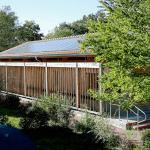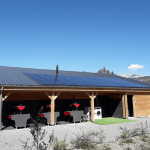All-Electric House by Vaillant and Helena Innovation with DualSun panels – Berkel Rodenrijs (NL)
In the Netherlands, DualSun had been chosen by Helena Sustainable Innovations for their All-Electrical project with Vaillant to get rid of the gas in houses and reduce the CO2 footprint as asked by the Dutch government.
The CEO of Helena Sustainables explained us the project and his conviction for solar energy and reduce our impact :




 Could you present yourself ?
Could you present yourself ?
Fred Verhaaren. director of Helena Sustainable Innovations B.V. I am an engineer mechanics from the University of Delft. I have worked for most of my life internationally in the oil & gas industry and rail infrastructure as a project director.
Privately I was executing the last 10 years pilot projects, to make our farmhouse/office all–electric zero emission. Three years ago I started my company Helena Sustainable Innovations B.V. with a vague idea to find a large scale solution for the energy transition of residential areas. The idea was to do this with a team of cooperating relative small innovative companies that can act quickly and don’t have the burden of stranded assets.
What do you think about solar energy ?
Solar energy has the future, not only because it is sustainable but also because it is economically attractive because of its low operating costs.
What is the All-Electrical Challenge ?
The all-electric challenge is a contest organised yearly by one of the Dutch environmental organisations “Natuur en Milieu” to promote initiatives to reduce the CO2 footprint.
Helena Sustainable Innovations B.V. (HelenaSI) installed end of 2017 a compact small ground source heat pump, GeoTHERM 3.1, from Vaillant to replace the existing gas heating boiler. This Helena all-electric concept uses PVT panels from DualSun to regenerate the ground source, which makes large scale application of ground source energy systems in densely populated areas possible. Vaillant invited HelanaSI early 2018 to participate in this contest. Vaillant and HelenaSI have won this contest in 2018 with the Helena all-electric concept.
Why did you choose the DualSun PVT technology ?
We selected DualSun because of the high performance, high quality PVT panel, that is scalable and suitable for mass production. One other consideration is ease of installation and reliability, especially with regard to the connections. An important consideration to Select DualSun as preferred supplier / partner of PVT panels was DualSun’s focus on continually improving their product from a life cycle point of view.
How you Could you explain how the panels are used in this first pilot house project you made ?
The PVT panels in the pilot house are directly integrated in the ground source loop. The PVT panels supply heat directly to the ground source. This system has now successfully been tested and monitored during two heating seasons 2017/2018 and 2018/2019. We have also conducted computer simulations for a closed loop ground source/ PVT/ heat pump system for a residential area of approx. 900 houses. The results are very promising. For his large scale application we have developed with our Partner Geo-Energie B.V. also a new drilling method specifically suitable for the built area.
How was the installation of the panels ?
The installations of the first generation connection kit was quite labour intensive and not suitable for application on the typical sloped roofs of Dutch houses. To have a minimum number of connection fittings on the roof, we had to bring each return and supply line into the house and connect it there to a manifold. However with the newly developed DualSun connection kit we can connect 5 panels in parallel straight on a supply and return header line, which makes installation much easier, more reliable and affordable.
Would you make an other project with DualSun ?
Sure, the cooperation with DualSun is very successful and pleasant.
Any recommendations ?
We recommend to take it step by step and continually improve. DualSun is such a partner that invests in and continually improves their product, with not only focus on the end product but also on the life cycle including installation and maintenance & management of an integrated system from an end user point of view.
Technical Information
| Characteristics | Unifamiliar house |
| Application | Domestic hot water, DHW + low-temperature heating |
| Number of solar panels | 6 PVT Spring panels + 7 PV Flash panels |
| Power output | 3,64 kWc + 6,33 kWth |
| Roof installation | On-roof installation |
| Thermal system | Geothermal wells regeneration + Vaillant GeoTHERM 3.1 heat pump |
| Photovoltaic system | self-consumption + battery storage |
| Installation date | 2018 |

 FR
FR  DE
DE  IT
IT  ES
ES  PT
PT  NL
NL 



